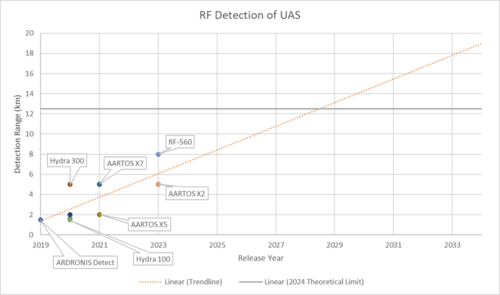Radio Frequency Counter UAS System
Roadmap Creators:
Time Stamp: 10 October 2024
Radio Frequency Counter UAS System
Roadmap Overview
Counter-Unmanned Aircraft Systems (C-UAS) are technologies developed to detect, track, and neutralize unmanned aerial vehicles (UAVs) in situations where they pose security threats. With the proliferation of drones around the world, C-UAS is essential to the future airspace security landscape. C-UAS are modular and interoperable with numerous platforms. Demonstrated technologies include radar, electro-optical/infrared, acoustic, and radio frequency sensors for drone detection, as well as communication signals jamming, cyber takeover, and directed energy applications (laser and electromagnetic) for drone mitigation. Due to the variety of C-UAS configurations, our roadmap focuses on radar detection and radio frequency (RF) jamming.
DSM Allocation
The above 2RFC tree shows the relationship between some systems related to the Counter UAS system that uses radio frequency as for detection and defeat. This tree says that the Counter UAS system consists of the detection system (3RFD), defeat system (3RFJ), classification & tracking system (3CTS), and command and control system (3CCS). In addition, these subsystems require several components such as an RF antenna (4RFA), RF jammer (4RFJ), a processor for classification and tracking (4CTP), command center (4CMC), and so on. As this DSM shows, The DSM indicates that each component is coupled to function as an RF counter UAS system.
Roadmap Model using OPM
Figures of Merit (FOM)
The table above summarizes a number of different Figures of Merit (FOM) for the C-UAS System. The complete system that detects and defeats will have similar FOMs on either side of the chain, and we've selected to focus on Detect as the key FOM. Detect ranges are one of the more widely publicly available data metrics for such systems. However, each entity may not utilize the same metrics for comparison. This study makes the assumption that detection range metrics from different suppliers are one-to-one.
Charting a range of C-UAS RF Systems from worldwide suppliers shows an increasing detection range versus time with a wide data spread.
Technical Model
FOM Sensitivity
The FOM of the counter UAS system is shown above. Among them, we formulate the detection range and probability of detect and evaluate their sensitivity.
Detection Range
Here, GTx, PTx, and f are values determined by the UAS to be detected, but considering that the system's performance varies depending on the detection target, we will check the impact of these values.
When the partial derivatives of each variable are calculated, the partial derivatives for all variables except f are low values. Therefore, the influence of these variables on the detection distance, which is an important index in evaluating the performance of the system, is easy to interpret.
Next, we evaluate the sensitivity of the detection distance d to each variable. Here, the rate of change in the detection distance is shown for a 1% increase in each variable from the reference value.
The results show that improving the receiver's receiver sensitivity is strongly influenced by improving the detection distance. It is necessary to construct a system that can detect UAS even when the reception level is low.
Probability of Detect
Here, since the detection probability follows a logistics function, the result of the partial differentiation of each variable shows a sigmoidal slope. Thus, a positively large value of the partial derivative implies a higher probability of detection. Next, we evaluate the sensitivity of the probability of detection to each variable. Here, the rate of change in the detection distance is shown for a 1% increase in each variable from the reference value.
The results show that improving the receiver's receiver sensitivity is strongly influenced by improving the probability of detection. Despite the different indicators and different derivation assumptions in the equations, the most contributing variables are consistent with the results for detection distance, and the results for each are considered plausible.











